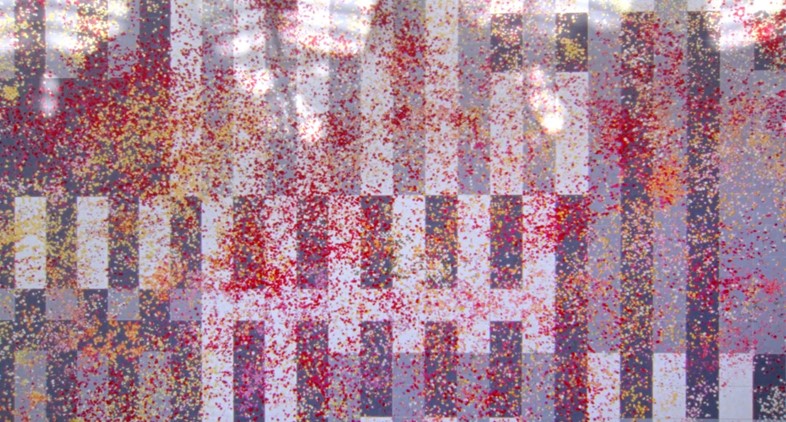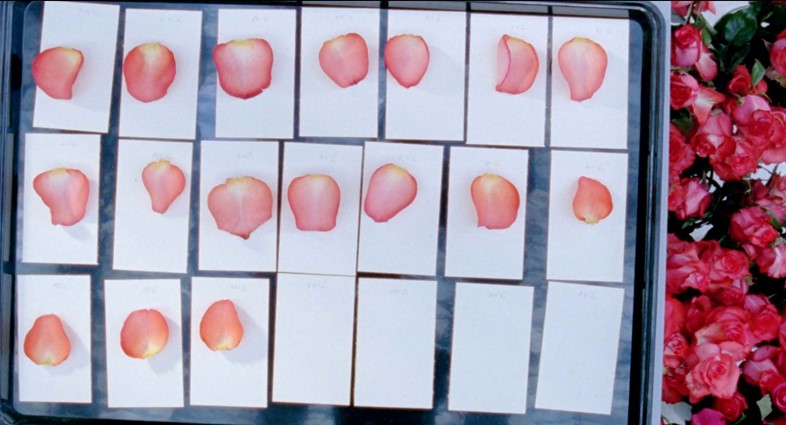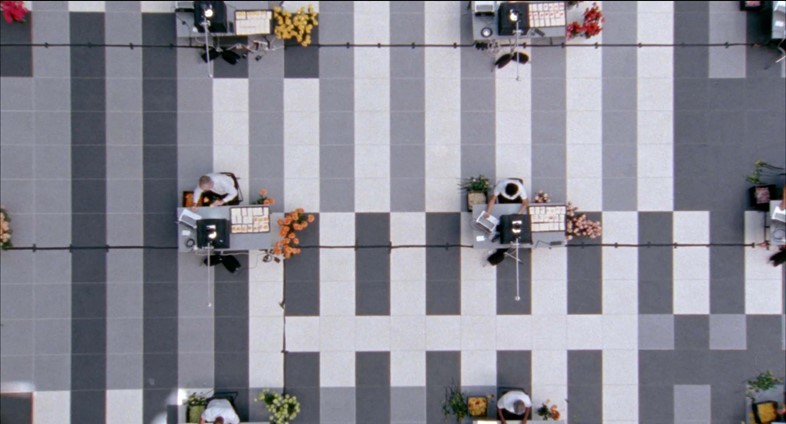Nature, data and artificial intelligence combine to powerful effect in Sarah Meyohas‘ new exhibition – a exercise in the artificiality of beauty as we experience it
In August 2016, artist Sarah Meyohas undertook an extraordinary installation in the atrium of the former Bell Labs complex – a scientific research and development laboratory based in New Jersey. Over the course of several days, 16 temp workers plucked and photographed the individual petals from 10,000 roses, creating a digital data set with the results. Afterwards, the artist worked with a team of machine-learning experts to implement an algorithm to effectively learn how to generate ‘new’ rose petals, based on this data set.
A senseless exercise in data entry? Meyohas doesn’t dispute. “It’s infinite amounts of rose petals. It’s the most frivolous endeavour!” she says. “But it’s almost pretty serious – it’s playing God, trying to recreate nature.” Meanwhile, she filmed the whole installation on 16mm film – a clip from which film premieres on Nowness today. It’s this combination of related elements which comprise her new exhibition, Cloud of Petals, which opens this week at Red Bull Arts in New York. There’s the resulting film; an archive wall holding the 3,289 “most beautiful” organic petals, like an elite taxonomy of rose petals, pressed under glass (an exercise in the workers’ subjectivity, preserved as a relic of the process); a series of mirrored booth sculptures made with modular steel panels from Bell Labs; and a VR experience in which both the real petals and the generated ones flutter, fly and explode all over the exhibition’s visitors.
Together, these elements interrogate beauty as we know it. While on the one hand, Cloud of Petals seems a frivolous exercise in the new limits of manmade technology – why wait for roses to grow when we can generate them ourselves? – on the other, it serves as a philosophical meditation. “One of my friends is a philosopher, and he locates this show as a meditation on the world after the death of God, and the death of nature,” Meyohas tells me. “Because nature only has meaning insofar as we ascribe to it – and we’ve destroyed nature, and we are destroying it. And so in all of this there’s a memorial.” The day after the exhibition opening, we spoke to Meyohas to find out more.

On the role the venue played in the project…
“I showed up there and fell in love with the space. It’s a two-million square foot Eero Saarinen building in the middle of New Jersey, and it was the birthplace of information technology. There’s a long history of collaboration between art and technology that came out of Bell Labs. It funded some amazing breakthrough research, because it was a monopoly. So it’s kind of a legend as far as American corporate technology-history goes.”

On the resonance of other aspects in the film…
“The temp workers were at these stations on this floor pattern that was based on a design by Josef Albers, which made sense given his focus on colour theory, and also colours as they relate to touch – the more haptic perception. So they were on this floor pattern doing this manual labour, this data entry, essentially, cataloguing all these petals, and I got a data set of 100,000 images. And, meanwhile, I filmed the whole thing on 16mm, which was obviously a conceptual decision, given that the piece is about digital images and big data, and how computers see images. And there were other elements in the film – there’s a 14-foot python snaking through switchboard wires, and vultures on the roof, there’s dead flies, live flies. So there’s this kind of animism. The snakes had some biblical undertones, as well as also looking like the wires in the building.”

On the importance of glass in her work…
“I made these mirrored booths with modular steel wall panels from Bell Labs, and elements from the switchboard room, which I literally just went down there and cut out. Those are also kind of like these reliquaries. They’re kind of like telephone booths, and Bell invented telephones. The building itself is all mirrored glass – it was the biggest mirror in the world according to Architectural Digest, when it was designed. It’s kind of an inversion of the architecture, because the mirror now is facing inwards, but it creates this infinite hallway, which is an allusion also to the virtual space that they created.
“This also echoes the photographs that I make with two-way mirrors, that I call Speculations – I’m interested in desire, and the void, and glass, and glass as it relates to technology – I use a lot of glass. I find it is an amazing thing to use, because it’s lenses, and photography, obviously, and then it’s also historically ‘the looking glass’, and time gets confused in glass. It’s also futuristic – like Google Glass, and all our screens are glass. It’s super flat, and super depth.”

On the VR experience she created for the exhibition...
“It’s six different screens, and they’re all hanging. Meanwhile, there is rose scent – I worked with Celine Barel from IFF, International Flavours and Fragrances, and she helped design the scent – being pumped into the room as you put your headset on. In the headsets are different particle systems. What that means is that there are rose petals, both real and generated ones, flying around you, which are gaze-activated. So depending on where you look, different things happen. There’s one headset and you look at a petal and it explodes into pixels, and the shape of how the pixels move is based on the noise in the image – it’s a noise-generated thing. There’s one where you look down and the petals fly up, and they fall down around you… It’s hard to describe.
“I think about the VR in two ways. On one hand, it’s a metaphor for the machine-learning. You’re a point within these particle systems. It’s not like when you look at an artwork and you’re fronted physically – you stand before it and your physical body informs how you look at it. With VR you’re one perspective.
“I also think of it narratively. These workers are photographing these petals, and their work is made obsolete by the AI that learns to generate new and more petals, and what are the petals used for? There’s this commemorative act at Bell Labs, and then there’s this sort of future, where it’s like we’ve put nature into this virtual environment. It’s both magical and enchanting, and my 60-year-old mother can have the most amazing experience, but it’s also like, what are the petals for? What about touch? What about scent? And that relationship starts to be questioned.”

On what drew her to petals in the first place…
“I literally had a dream that is now very close to what the VR looks like. I had read Giuliana Bruno – she has a book on surfaces [Surface: Matters of Aesthetics, Materiality, and Media] and I had read Elaine Scarry’s writing on beauty [On Beauty and Being Just] – she talks about flowers. Not necessarily petals, but flowers as objects that have fascinated artists, because the shape of a flower and the colour are much closer than in other things, and the size of flowers is small enough that you can hold them in your mind’s eye much better than you can other objects, essentially because of this relationship between the colour and the form and the scale of it. So that was an influence.
“Roses are also the most significant flower, for love and beauty, and they’re also super commercial. They’re grown everywhere and they’re a big business. So that dichotomy was interesting to me.”
Cloud of Petals runs until December 10, 2017, at Red Bull Arts, New York.